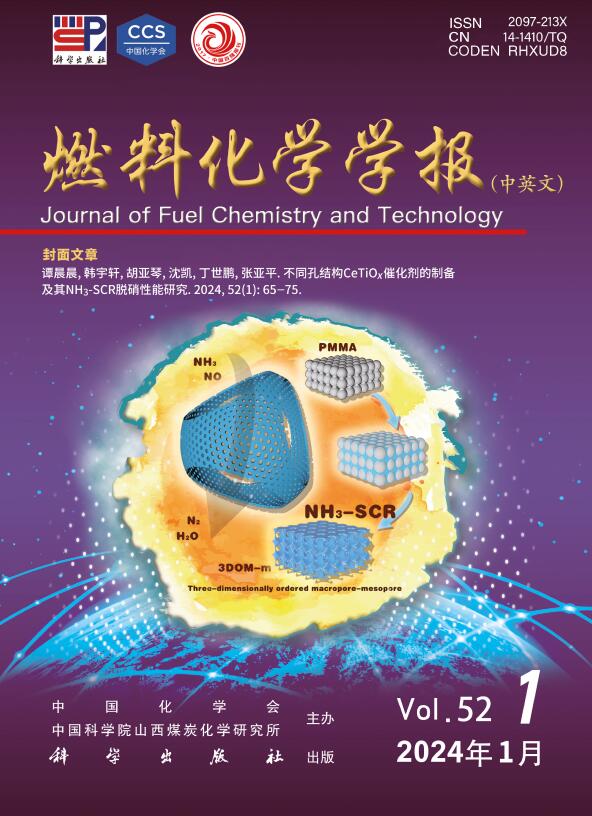Influence of Cu grain size on the performance of Cu-based catalyst in the gas-phase hydrogenation of ethyl levulinate
Q3 Energy
引用次数: 0
Abstract
γ-valerolactone (GVL) is a platform chemical derived from lignocellulose, which can be used as fuel additives, green solvent and feeding for the production of other high-value chemicals. Its efficient synthesis is of great significance for the development and utilization of biomass downstream products. Herein, with CuZnAl hydrotalcite as the precursor, a series of Cu-based catalysts with different Cu grain sizes were prepared by changing the aging temperature and used in the solvent-free gas-phase hydrogenation of ethyl levulinate (EL) to produce GVL. The Cu-based catalysts were systematically characterized by various techniques such as N2 sorption, XRD, SEM, TEM, H2-TPR, NH3-TPD, and in situ XPS, while the effect of Cu grain size on the performance of Cu-based catalyst in the EL hydrogenation was investigated. The results indicate that the electron cloud density of Cu as well as the Cu0/(Cu0+Cu+) ratio increase with a decrease of the Cu grain size; in addition, the Cu-based catalyst prepared by aging at a low temperature displays a large surface area and abundant acid sites. The synergistic effect of Cu0 sites and acid sites endows the Cu-based catalyst with superior performance in the EL hydrogenation to GVL. In particular, for the EL gas-phase hydrogenation under mild conditions (atmospheric pressure, 140 ℃, 0.3 h−1), the Cu-based catalyst prepared by aging at 30 ℃ achieves an EL conversion of 99.9% and a selectivity of 99.5% to GVL, with no significant deactivation observed in 240 h. The insight shown in this work should be meaningful for the large-scale production of GVL.
铜晶粒尺寸对乙酰丙酸乙酯气相加氢铜基催化剂性能的影响
γ-戊内酯(GVL)是从木质纤维素中提取的平台化学品,可作为燃料添加剂、绿色溶剂和生产其他高价值化学品的进料。其高效合成对生物质下游产品的开发利用具有重要意义。本文以CuZnAl水滑石为前驱体,通过改变时效温度制备了一系列不同Cu晶粒尺寸的Cu基催化剂,并将其用于乙酰丙酸乙酯(EL)的无溶剂气相加氢制备GVL。采用N2吸附、XRD、SEM、TEM、H2-TPR、NH3-TPD、原位XPS等技术对Cu基催化剂进行了系统表征,并考察了Cu晶粒尺寸对Cu基催化剂EL加氢性能的影响。结果表明:随着Cu晶粒尺寸的减小,Cu的电子云密度和Cu0/(Cu0+Cu+)比值增大;此外,低温老化制备的cu基催化剂具有较大的比表面积和丰富的酸位。Cu0位与酸位的协同作用使得cu基催化剂在EL加氢制GVL中具有优异的性能。特别是在温和条件下(大气压,140℃,0.3 h−1)的EL气相加氢,30℃时效制备的cu基催化剂对GVL的EL转化率为99.9%,选择性为99.5%,在240 h内未观察到明显的失活现象。本研究成果对GVL的大规模生产具有重要意义。
本文章由计算机程序翻译,如有差异,请以英文原文为准。
求助全文
约1分钟内获得全文
求助全文
来源期刊

燃料化学学报
Chemical Engineering-Chemical Engineering (all)
CiteScore
2.80
自引率
0.00%
发文量
5825
期刊介绍:
Journal of Fuel Chemistry and Technology (Ranliao Huaxue Xuebao) is a Chinese Academy of Sciences(CAS) journal started in 1956, sponsored by the Chinese Chemical Society and the Institute of Coal Chemistry, Chinese Academy of Sciences(CAS). The journal is published bimonthly by Science Press in China and widely distributed in about 20 countries. Journal of Fuel Chemistry and Technology publishes reports of both basic and applied research in the chemistry and chemical engineering of many energy sources, including that involved in the nature, processing and utilization of coal, petroleum, oil shale, natural gas, biomass and synfuels, as well as related subjects of increasing interest such as C1 chemistry, pollutions control and new catalytic materials. Types of publications include original research articles, short communications, research notes and reviews. Both domestic and international contributors are welcome. Manuscripts written in Chinese or English will be accepted. Additional English titles, abstracts and key words should be included in Chinese manuscripts. All manuscripts are subject to critical review by the editorial committee, which is composed of about 10 foreign and 50 Chinese experts in fuel science. Journal of Fuel Chemistry and Technology has been a source of primary research work in fuel chemistry as a Chinese core scientific periodical.
 求助内容:
求助内容: 应助结果提醒方式:
应助结果提醒方式:


